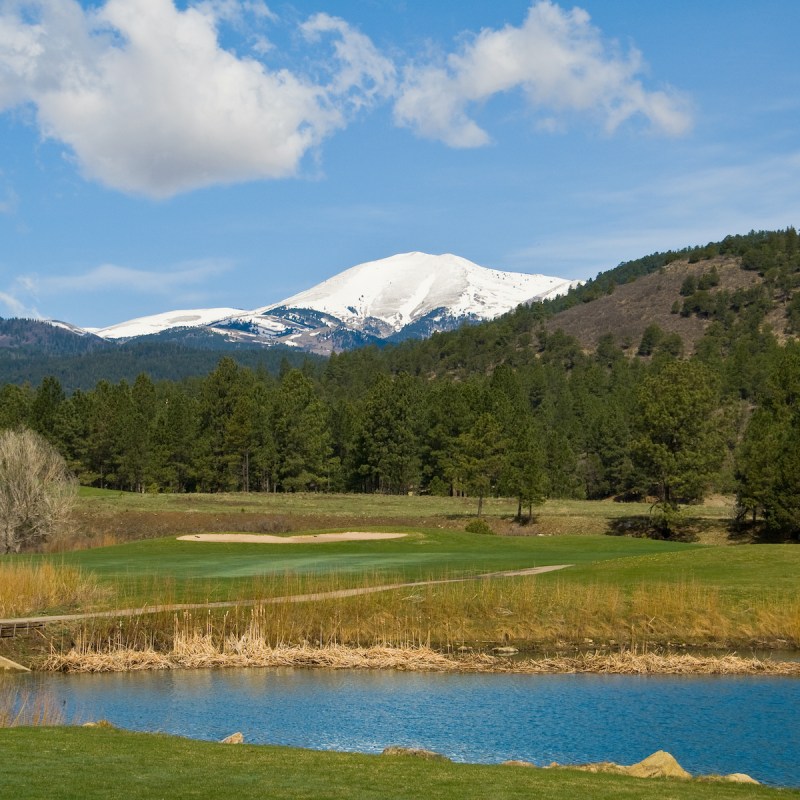
Deep cerulean skies, white cottony clouds, wide-open desert spaces, and the distant Sacramento Mountains yielded to the two-lane highway sharply rising before us. The afternoon rain shower brought the changing scents of dusty desert cactus to cedar shrubs to towering ponderosa pine forests, and the road twisting and turning along the Rio Penasco. By the time we reached Mayhill, we had ascended 6,495 feet in elevation, and the temperature felt 15 degrees chillier. This road leads to my seven favorite small towns along a picturesque drive in southern New Mexico with unforgettably majestic scenery and iconic recreational areas.
Videos by TravelAwaits
Fishing Fact: The Rio Penasco is a 40-mile spring-fed creek, one of the finest but little-known trout streams in the New Mexico desert country. When you become a Mesilla Valley Fly Fisher in Las Cruces, New Mexico, you have access to a 2-mile lease of the Penasco at the Runyon Ranch. Flyfish for trout, both stocked and wild, when you purchase a reasonably priced daily permit from the club. This fishing is catch-and-release only using a single no-barb fly hook.

1. Cloudcroft
The Village of Cloudcroft is known for its high elevation (9,000 feet), comfortable cabins, the iconic Cloudcroft Lodge, and an excellent place for fishing, horseback riding, hiking, camping, biking, and in the winter, skiing and ice skating.
At 9,100 feet in elevation, Ski Cloudcroft, with 25 excellent trails, groomed with extra snowmaking equipment, is the southernmost ski area in New Mexico. The double chair lift, handle tow lift, and rope tow lift make for a fun time getting up the mountain. Enjoy Cloud Nine Ski School for exceptional family fun.
The Lodge Resort & Spa at Cloudcroft is a charming historic hotel with 59 luxurious guest rooms with antique furnishings offering a Victorian blend of history, charm, and intrigue. You’ll want to visit the haunting presence of the resort and explore its ghostly past.
Tee off at the seventh-highest in the world, The Golf Course at the Lodge, where you play the nine-hole system twice, by the Scottish tradition, driving from different tees and putting to separate flags. You’ll be surprised how far your drives travel at this altitude!
For the wine enthusiast, Noisy Water Winery has five locations with a vineyard in Alto, near Ruidoso. You can purchase some pinot noir, chardonnay, Petit Sirah plus, gourmet foods like balsamic vinegar, cheese, olive oil, pistachios, sauces, and chili products.
Cloudcroft Brewing offers craft beers like adobe wheat, train wreck IPA, and something called the seasonal, with new favorites brewing every day. Sample a flight of beers when you visit.
About 14 miles south of Cloudcroft, visit Sunspot Solar Observatory to see instruments used to study the sun. Tour the wheelchair-accessible museum and gift shop. Don’t miss the magnificent view of the Tularosa Basin from Sunspot — more significant than Connecticut.

2. Mescalero
The Mescalero Apache Tribe operates both the Ski Apache and Inn of the Mountain Gods Resort & Casino.
Ski Apache, one of the country’s southernmost major ski areas, offers an alpine mountain Sierra Blanca at over 12,000 feet, with an annual snowfall of over 15 feet. You’ll find plenty of snow at Ski Apache, with snowmaking on 33% of the mountain. Ride 11 lifts, including an eight-passenger Gondola to the top.
In the summer, rent mountain bikes for adults and children with helmets, gloves, and accessories. Enjoy hiking trails, disk golf, gondola rides, and a fantastic zip line ride on the mountain. This incredible three-part zip tour reaches over 8,900 feet in length, making it one of the most extended zip tours in the world.
Inn of the Mountain Gods offers luxury spa services, upscale hotel rooms, and suites with gorgeous lake views, plus first-rate golfing, Apache Eagle zip lining, fishing, kayaking, hiking, biking, and horseback riding. Have fun with Vegas-style gaming, thrilling slots, plus an entertaining nightlife filled with national concerts and stand-up comedy.

3. Ruidoso
Ruidoso, the Sierra Blanca mountain-oasis, is famous for winter skiing, summer horse racing, plus horseback riding, hiking, and camping amid alpine forests and picturesque mountain views. Enjoy rustic cabins, comfortable hotels, and luxurious lodges and resorts.
We love to explore Ruidoso’s Midtown public art murals with over a dozen opportunities for Instagram selfies. See the Village Buttery by Jeff Hayes and Noisy Water Winery by Lucas Aoki, and more.
Visit Midtown for shopping and all things fun. Support local merchants at one-of-a-kind boutiques and active lifestyle retailers. Take a walking tour of the art galleries, and access the history guide for visits to The Hubbard Museum of the American West, Fort Stanton State Historic Site, and Billy The Kid Scenic Byway.
Ruidoso offers top cafes and restaurants for excellent eats. Enjoy the Log Cabin Restaurant for breakfast, and soups and sandwiches at the Village Buttery. Savor Italian pasta, seafood, steak, chicken, or veal dishes at Michael J’s Italian-American Cuisine, plus wine by the glass or bottle.
Amid a 46,963-acre Lincoln National Forest backcountry, you’ll find White Mountain Wilderness, 15 miles northwest of Ruidoso. With dozens of hiking trails in the area, the elevations span 11,580 feet near Lookout Mountain to the south. Protected wildlife includes mule deer, elk, black bear, bobcat, gray fox, coyote, and rock squirrels. The area serves as a critical habitat for several species of birds. Besides hiking, the space is open to backpacking, horseback riding, and “leave no trace” camping.

4. Capitan
The village of Capitan, nestled between the Capitan and Sacramento Mountains at 6,530 feet, is best known as Smokey Bear’s birthplace and burial site. A fire-fighting crew discovered the badly-singed cub clinging to a burned pine tree in the Capitan Gap wildfire. Game Warden Ray Bell flew the cub to a Santa Fe veterinary hospital to care for his burns. Later, Smokey flew to Washington, D.C., to make his new home in the National Zoo.
Congress passed a bill in 1952 establishing the name and image of Smokey Bear. When he died in 1976, Smokey was returned to the Capitan Mountains and rested in peace at a small park in Capitan. Visit the Smokey Bear Historical Park and Visitor’s Center, the museum, and the gift shop. I remember Smokey Bear as a kid: “Only YOU can prevent forest fires!”
Capitan Mountains Wilderness Area has 35,091 acres, located northeast of Capitan. The Wilderness runs 12 miles long and 2–6 miles wide, with altitudes over 10,000 feet on Capitan Peak. Hike the Capitan Peak Trail up 5.7 miles of steep switchbacks to reach El Capitan’s summit. You’ll see mule deer, wild turkey, and black bears, plus you can fish the streams for trout.

5. Carrizozo
Carrizozo Heritage Museum houses the history of Carrizozo in an old brick cold storage warehouse. See a video of the town’s history, plus exhibits that include movies filmed in the Carrizozo area.
Painted burros came about when the Malkersons invested in a herd of aluminum burros, scattered them about the town, and invited local artists to paint the beasts. Additionally, they sell painted mules to help animal rescue efforts and have fun responding to the challenges of fitting them into buyers’ cars, waving good-bye to the curious face poking out the window.
Honey Girl’s Café et Chocolat offers craft organic, fair-trade coffee, organic tea, small bites like the ham and cheese croissant, Mexican pastries, hand-crafted organic pies, and artisan chocolate. A delightful secret garden through the gate at the back of the café offers a relaxing seating area. Try the valley of fire, the most popular drink made with chocolate, cinnamon, and habanero.
Four miles west of Carrizozo, the Valley of Fires National Recreation Area boasts a 5,000-year-old lava flow 4–6 miles wide, 160 feet deep, and covers 125 square miles. From a distance, the Valley of Fires looks like barren rock, but take a walk, and surprisingly, you’ll see desert flowers and cacti along with mule deer, rabbits, quail, and lizards. For birdwatchers, you can see a paradise filled with owls, turkey vultures, hawks, cactus wrens, sparrows, and golden eagles.

6. Three Rivers
Twenty-eight miles south of Carrizozo, three rivers merge: Indian Creek, Golondrina “Swallow” Creek, and Three Rivers.
Five miles off the road, the Three Rivers Petroglyphs Site, dating back between 900 and 1400 AD, features more than 21,000 glyphs of humans, animals, fish, birds, insects, and plants, plus numerous abstract and geometric designs. Created by the Jornada Mogollon people, the petroglyphs scatter over 50 acres of New Mexico’s Chihuahuan Desert.
Trails from the visitor shelter lead you to the petroglyphs, plus the remains of a Mogollon village with foundations of three types of prehistoric buildings. Three Rivers Campground offers five shelters, two RV sites, and one group site with restrooms and drinking water.

7. Tularosa
Tularosa gets its name from the Spanish description for the rose-colored reeds growing along the banks of the Rio Tularosa. In 1979, the National Register of Historic Places added the 49-block original townsite.
David Wickham opened Tularosa Vineyards in 1989, producing 100 cases, with his son Chris, who joined the winery as an active winemaker in 1995. Today the winery produces 3,500 cases of high-quality award-winning wines, open for daily tastings and tours by appointment.
St. Francis De Paula Church was constructed from 1868–1869 after a prayer to St. Francis de Paula and a solemn promise to build a church after the battle of Round Mountain, fought successfully to save Tularosa settlers from the Apache.
Stay at Valley Lodge Mae West Room, a refurbished 1863 adobe-style boarding house hosted by Joe Ben, a Tularosa native and archaeologist. Climb the wooden spiral staircase to your room. Enjoy a tasty breakfast, and don’t miss the bookstore.
